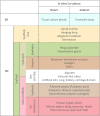Key aspects for conception and construction of co-culture models of tumor-stroma interactions
- PMID: 37091337
- PMCID: PMC10119418
- DOI: 10.3389/fbioe.2023.1150764
Key aspects for conception and construction of co-culture models of tumor-stroma interactions
Abstract
The tumor microenvironment is crucial in the initiation and progression of cancers. The interplay between cancer cells and the surrounding stroma shapes the tumor biology and dictates the response to cancer therapies. Consequently, a better understanding of the interactions between cancer cells and different components of the tumor microenvironment will drive progress in developing novel, effective, treatment strategies. Co-cultures can be used to study various aspects of these interactions in detail. This includes studies of paracrine relationships between cancer cells and stromal cells such as fibroblasts, endothelial cells, and immune cells, as well as the influence of physical and mechanical interactions with the extracellular matrix of the tumor microenvironment. The development of novel co-culture models to study the tumor microenvironment has progressed rapidly over recent years. Many of these models have already been shown to be powerful tools for further understanding of the pathophysiological role of the stroma and provide mechanistic insights into tumor-stromal interactions. Here we give a structured overview of different co-culture models that have been established to study tumor-stromal interactions and what we have learnt from these models. We also introduce a set of guidelines for generating and reporting co-culture experiments to facilitate experimental robustness and reproducibility.
Keywords: cancer associated fibroblasts; cell culture models; co-culture; organoid; tumor-stroma interactions.
Copyright © 2023 Mason and Öhlund.
Conflict of interest statement
The authors declare that the research was conducted in the absence of any commercial or financial relationships that could be construed as a potential conflict of interest.
Figures




Similar articles
-
Development of primary human pancreatic cancer organoids, matched stromal and immune cells and 3D tumor microenvironment models.BMC Cancer. 2018 Mar 27;18(1):335. doi: 10.1186/s12885-018-4238-4. BMC Cancer. 2018. PMID: 29587663 Free PMC article.
-
Molecular insights into prostate cancer progression: the missing link of tumor microenvironment.J Urol. 2005 Jan;173(1):10-20. doi: 10.1097/01.ju.0000141582.15218.10. J Urol. 2005. PMID: 15592017 Review.
-
Tumor organoid models in precision medicine and investigating cancer-stromal interactions.Pharmacol Ther. 2021 Feb;218:107668. doi: 10.1016/j.pharmthera.2020.107668. Epub 2020 Aug 24. Pharmacol Ther. 2021. PMID: 32853629 Free PMC article. Review.
-
Fabrication Method of a High-Density Co-Culture Tumor-Stroma Platform to Study Cancer Progression.Methods Mol Biol. 2021;2258:241-255. doi: 10.1007/978-1-0716-1174-6_16. Methods Mol Biol. 2021. PMID: 33340365
-
Modeling colon adenocarcinomas in vitro a 3D co-culture system induces cancer-relevant pathways upon tumor cell and stromal fibroblast interaction.Am J Pathol. 2011 Jul;179(1):487-501. doi: 10.1016/j.ajpath.2011.03.015. Epub 2011 Apr 30. Am J Pathol. 2011. PMID: 21703426 Free PMC article.
Cited by
-
Harnessing 3D models to uncover the mechanisms driving infectious and inflammatory disease in the intestine.BMC Biol. 2024 Dec 31;22(1):300. doi: 10.1186/s12915-024-02092-9. BMC Biol. 2024. PMID: 39736603 Free PMC article. Review.
-
Adipose Tissue in Breast Cancer Microphysiological Models to Capture Human Diversity in Preclinical Models.Int J Mol Sci. 2024 Feb 27;25(5):2728. doi: 10.3390/ijms25052728. Int J Mol Sci. 2024. PMID: 38473978 Free PMC article. Review.
-
From lab to life: technological innovations in transforming cancer metastasis detection and therapy.Discov Oncol. 2025 Aug 10;16(1):1517. doi: 10.1007/s12672-025-02910-8. Discov Oncol. 2025. PMID: 40783899 Free PMC article. Review.
-
Recent Advances in Barnacle-Inspired Biomaterials in the Field of Biomedical Research.Materials (Basel). 2025 Jan 22;18(3):502. doi: 10.3390/ma18030502. Materials (Basel). 2025. PMID: 39942168 Free PMC article. Review.
-
Proximity Labeling and SILAC-Based Proteomic Approach Identifies Proteins at the Interface of Homotypic and Heterotypic Cancer Cell Interactions.Mol Cell Proteomics. 2025 Jun;24(6):100986. doi: 10.1016/j.mcpro.2025.100986. Epub 2025 May 5. Mol Cell Proteomics. 2025. PMID: 40334745 Free PMC article.
References
Publication types
LinkOut - more resources
Full Text Sources

